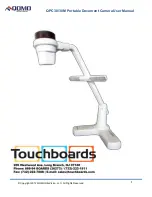
- use this reference to quickly recall your particular setting when
more than one person will be looking through the viewfinder.
If a corrective lens is required, one can be fitted in the recessed area
of the eyecup ring of both the standard eyepiece and the extension
finder.
2.2.5 The Eyepiece Shutter
In order to avoid light seepage through the viewfinder, the eyepiece
shutter must be closed any time the camera is running film and the
operator’s eye is away from the viewfinder.
Locate the black wheel under the base of the carrying handle. To
close the eyepiece shutter, turn this wheel counter-clockwise. To
open it, turn the wheel clockwise.
2.2.6 Adjusting the Viewing Horizon
If the rotation of the image seen through the camera’s viewfinder
does not exactly match what is seen through the naked eye, there is
a fine adjustment that can be made to the image’s relative horizon.
Locate the small slotted screw located on the underside of the view-
finder inside the eyepiece lock ring. Notice that the screw travels in
an elongated cutout. Loosen the screw one turn and, while looking
through the viewfinder, move the screw within its cutout in order to
adjust the horizontal rotation. When the images seen through your
left and right eyes coincide, lock the screw.
2.2.7 Viewing Screen
The AATON 35-III utilizes an interchangeable viewing screen (or
“ground-glass”) system which allows the cinematographer to install
the screen which best suits his particular application. Aaton offers
12 viewing screens as standard (see section Viewing Screens in the
Technical Specifications chapter).
Custom screens can also be manufactured upon request. Contact
your local Aaton representative for details.
2.2.8 Changing the Viewing Screen
Checking your viewing
horizon
there is a simple means of
determining whether adjust-
ment of the horizon needs to
be made. Mount a zoom lens
onto the camera and rest the
camera on your shoulder in a
standard handheld position.
Look through the viewfinder
with your right eye while also
keeping your left eye open.
Compose a frame that includes
vertical or horizontal
lines (a window frame for
example) and adjust the zoom
on the lens so that the focal
length of the lens generally
matches what you see with
your left eye.
Ignore the viewing screen mar-
kings for the time being and
determine whether the rotation
of the image you see through
the viewfinder matches what
you see with your left eye. If it
does not, then a find adjust-
ment may be necessary.
23
THE CAMERA BODY
USER 35 US 23/1 -2 1/20/98 19:46 Page 23
Summary of Contents for 35-III
Page 1: ...User s Guide June 97 3 5 I I I...
Page 2: ...2...
Page 3: ...3 INTRODUCTION...
Page 10: ......
Page 11: ...GENERAL OVERVIEW 11 1...
Page 17: ...17 GENERAL OVERVIEW...
Page 18: ......
Page 19: ...THE CAMERA BODY 19 2...
Page 44: ......
Page 45: ...THE MAGAZINE 45 3...
Page 51: ...51 THE MAGAZINE...
Page 52: ......
Page 53: ...THE AATON SYSTEM 53 4...
Page 60: ......
Page 61: ...CLEANING 61 5...
Page 66: ......
Page 67: ...SUPER35 67 6...
Page 71: ...71 SUPER35...
Page 72: ......
Page 73: ...3 PERF FORMAT 73 7...
Page 76: ......
Page 77: ...AATONCODE 77 8...
Page 84: ......
Page 85: ...TECHNICAL SPECIFICATIONS 85 9...
Page 89: ...89 TECHNICAL SPECIFICATIONS...
Page 90: ......
Page 91: ...WORLDWIDE SUPPORT 91 10...
Page 96: ......
Page 97: ...INDEX 97 11...
Page 99: ...99 INDEX...
Page 100: ...100...
Page 101: ...101 INDEX...
















































